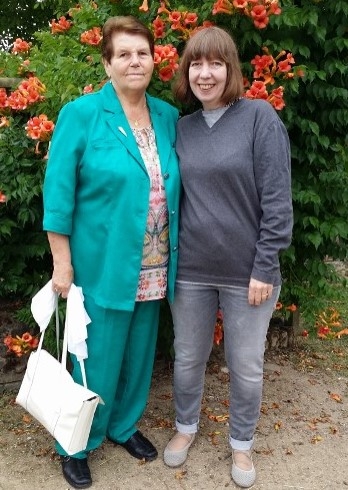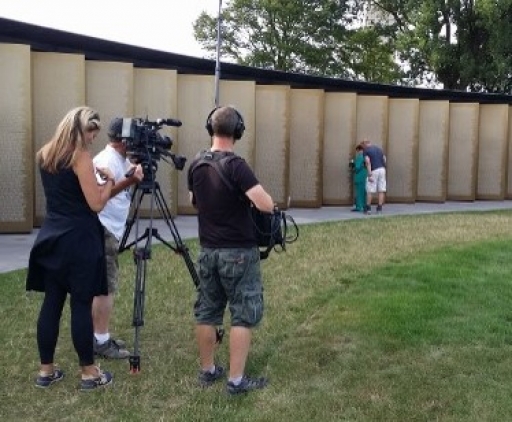This feature has been written by Centenary News volunteer writer Katherine Quinlan-Flatter with Louise Bray.
BBC TV documentary explores Welsh history on the Somme through the eyes of rugby player Gareth Thomas
In early July 2015, Centenary News was contacted by Louise Bray of Bearhug TV, who had been commissioned by the BBC to produce a documentary about the iconic Welsh battle of Mametz Wood which took place between July 7 and 12, 1916 on the Somme in Northern France.
Louise and her colleague Jobim Sampson were seeking a German descendant of a soldier who had fought on the side of the Central Powers in 1916 in or around the area of Mametz Wood, which is located near the small town of Albert in French Picardie. The documentary, funded by BBC Wales, primarily has a Welsh angle and is presented by the popular former rugby player Gareth Thomas, who lost two great-uncles in the area around Mametz during the Great War.
For the documentary, Bearhug TV commissioned a unique archaeological dig on the Somme. Against the backdrop of the dig, Gareth makes emotional discoveries about his family history and gains insight into the brutal realities of life on the front line in WW1. Gareth’s parents were also involved in the filming and Louise wanted to include a meeting between Gareth and a German “counterpart” whose relatives had also fought in the area.
Centenary News established the contact between Louise and myself, a Centenary News contributor from Germany who researches the Great War’s impact on my hometown of Ettlingen in Baden.
Louise and I quickly established that at least one regiment from Ettlingen had been present in the area of Mametz in the summer of 1916 and that there was a high probability that they might have even fought in the Battle of Mametz Wood.
One descendant from Ettlingen, Brigitte Weber, had two uncles who had been involved in fighting in the Mametz area. Bearhug TV invited Brigitte and myself to take part in the documentary and we travelled to France to meet the production team and film in August 2015.
BBC Programme
The programme had been in the planning stage for around two years, Louise explained, in light of the upcoming centenary of Mametz Wood in 2016. Both Louise and Jobim have substantial experience in producing archaeology programmes for the BBC and were delighted to have been commissioned to make such a unique programme, as an archaeological investigation adds a scale quite distinctive from a straight narrative.
In principle, the documentary follows three strands – Gareth’s story, the archaeological dig and the historical narrative of the Battle of Mametz Wood.
By using a well-known contributor such as Gareth Thomas, explains Louise, complex subject matters can be expressed in a more accessible way. Gareth was chosen because he had ancestors who were involved in the Battle of the Somme and is a popular and well respected personality in Wales – the former captain of the Welsh rugby team.
In addition, he has harboured an interest and passion in the Battle of the Somme for a number of years. Bearhug TV felt that he would help to appeal to a different demographic of people to the programme – those who might not normally be interested in history.
Gareth’s family previously had little information about the two lost uncles. However, they were all keen to be involved in the dig as well as the visits to memorials and cemeteries. Gareth and his father even tried on army uniforms and marched with full army kit. Through Gareth’s experiences, it is hoped that viewers will learn more about the lives of the Welsh soldiers on the front line and the history of the Battle of Mametz Wood.
Archaeological Dig
Bearhug set up and funded all elements of the archaeological dig. Archaeology is usually a very underfunded science so such an occurrence is rare. The archaeological team at Mametz consisted of between 15 and 20 people, including archaeologists, historians and a bomb disposal expert. Richard Osgood of the MoD was the Archaeological Director.
The job of this team was to dig at focused locations and to excavate the German trenches both in and outside of the wood. A LiDAR flight was commissioned over the wood in order to evaluate the topography of the landscape below the tree canopy and help the archaeological team focus their efforts on the ground.
The team’s motivation was that they were able to assess the strategy and logistics deployed during the battle. They were also interested in finding personal artefacts, from both sides, which would illustrate the human element behind the fighting. It was hoped that the dig would unearth new information and make new discoveries, and artefacts were indeed found that will help tell the story of the battle that was fought there for years to come.
From the historical point of view, the documentary charts the story of the Battle of Mametz Wood. Gareth is the eyes and ears of the viewer and while his personal journey is the over-arching story, he is also being provided with a lesson in history, as historical consultant Andy Robertshaw simultaneously teaches him the chronological order of events, imparting information that enlightens the viewer.

Brigitte Weber and Katherine Quinlan-Flatter
German Descendant
Brigitte Weber’s contribution was invaluable to the production. It had been very difficult to find a German descendant who fitted the brief, as having a German represented who mirrored Gareth’s story constituted a major part of the documentary. Whether Brigitte’s uncles were actually in Mametz Wood itself is unclear, but it is certain that they were stationed in the area at the time.
Two scenes between Gareth and Brigitte were filmed – a meeting in a café, during which they talked about their uncles, sharing photos and stories, and a joint visit to the new Ring of Remembrance memorial at Notre de Dame de Lorette to lay wreaths.
It was an emotional project for all those involved and Gareth admitted that he was deeply affected by the experience.
The project itself was not without its perils, due to the inherent dangers of working in such a wood, with live munitions being discovered on a regular basis even 100 years on. The wood is therefore classified as private property.
Mametz Wood is the largest wood on the Somme and measures approximately one mile square. The 38th Welsh Division suffered particularly huge losses during this battle. Today, their sacrifice is commemorated by the Welsh Dragon memorial that lies to the south east of the wood.
The programme is planned to air in June 2016.
